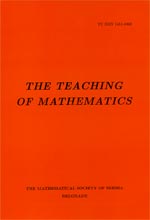
| Karamata's products of two complex numbers |
| Aleksandar M. Nikolić |
Abstract In his paper Über die Anwendung der komplexen Zahlen in der Elementargeometrie}, Bilten na Društvoto na matematičarite i fizičarite od N.R. Makedonija, kn. I, Skopje, (1950), 55--81 (in Serbian, resume in German) and in the university textbook Complex Numbers, Belgrade, 1950, Jovan Karamata (1902--1967) maintains that, in planimetry, a complex number can assume the role of a vector, whereby in definition and solving of certain problems, there appears the product $\overline{a} b=A+Bi$ where $\overline{a}$ is the conjugated number of $a$, while $a$ and $b$ are complex numbers which correspond to free vectors $\vec{a}$ and $\vec{b}$. Using geometric interpretation of $a$ and $b$, Karamata expresses $A$ and $B$ as $A=|a||b|\cos \alpha$ and $B=|a||b|\sin \alpha$. In order to underline the geometric sense of these expressions, Karamata denotes them as $A=(a\perp b)$, resp. $B=(a\mid b)$ designating them ``orthogonal product'' and ``parallel product''. By means of these two symbols, considered as products, Karamata interprets those problems in planimetry which correspond to parallelity and orthogonality, and shows how they can be used in deriving of Papos-Pascal and Desargues propositions. |
Keywords: Karamata, projective geometry, complex number, vector, Papos-Pascal, Desargues. |
Pages: 107$-$116 |
Volume VII , Issue 2 , 2004 |
